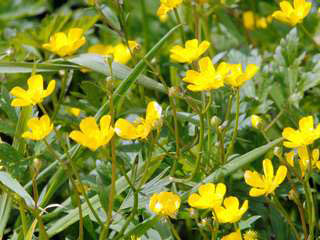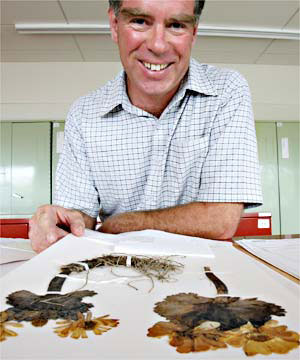Human Flower Project
Thursday, January 25, 2007
Split Hairs, Discover Buttercups
A hiker’s find and a botanist’s research claim a new species of buttercup in New Zealand, with an arsenal of lingo to back them up.

New Zealand’s newest wildflower: Ranunculus acraeus
Photo: Ross Setford, for NZPA
The New Zealand papers are splashed with yellow, as Ranunculus acraeus makes its public debut.
This beautiful buttercup was first collected in the 1940s, but botanists back then took it for “a subspecies of R haastii.” In 1998, a gardener from Christchurch, Joe Cartman, spotted the plant on a walk along Mount St. Mary, in North Otago, and took a specimen back to pro-botanist and friend Peter Heenan for a closer look.
After seven years of testing and minute comparison, Heenan has published his conclusion that Cartman’s find is indeed a species of its own.
He began like we all do—just eyeballing. Heenan noticed that the mystery buttercup was a whole lot showier than Ranunculus haastii: “The plant has grey foliage and it can form broad patches up to half a metre, so if you imagine a plant that diameter covered in yellow flowers, it’s quite attractive.” But “quite attractive” and “oh boy!” don’t cut it in the world of botany.
 Peter Heenan with pressed specimens of the buttercup he’s studied for seven years
Peter Heenan with pressed specimens of the buttercup he’s studied for seven years
Photo: Peter Meecham, The Press
It takes a lot of wonderfully fancy scientific nomenclature. The New Zealand Plant Conservation Network’s announcement of Ranunculus acraeus explains:
The new buttercup “is allied to R. piliferus but differs morphologically by its finely crenate leaf and bract margins, glabrous peduncle, and in having 6-7 sepals that are hairy on the abaxial surface and glabrous on the adaxial surface.”
Well, okay! Nobody’s looking, so feel free to use the links in that description or this good site that translates Botanese into English.
Basically, the new buttercup is different because its leaves have scalloped edges, its hairy stems hold just one flower apiece, and its sepals are hairy on the bottom and hairless on top.
After all that work, Heenan might fairly have named the flower for himself. He chose acraeus (“on high”) instead, for the plant’s alpine habitat—a name that could also shoo away collectors tempted to dig up this ranunculus and transplant it to their own gardens.
“Besides the fact you’re tampering with a rare native plant,” Heenan emphasized, “the buttercups don’t grow well at lower altitudes.” Meaning, you’ll have a dead flower in the yard and be wearing handcuffs on your pubescent wrists.




